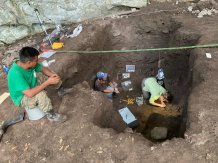Articles

UNM graduate student Paige Lynch conducting excavations at Mayahak Cab Pek in May 2019, part of ongoing UNM research into the earliest humans in the New World tropics.
Ancient stone tools found in remote rock shelter reveal vital clues about life in ancient Central America
Ancient stone tools found in remote rock shelters have revealed new clues about life in ancient Central America.
The discovery has allowed experts to learn more about how some of the earliest inhabitants of the region coped with extreme changes to their environment.
The multipurpose tools were made around 9,300 to 12,000 years ago and would have allowed people to hunt, skin animals, and process plants. Examining the tool has allowed researchers to see how the earliest humans in the Neotropics developed technologies to adapt to a dramatically changing environment at the end of the last ice age.
This is the first time experts have been able to accurately date the earliest tools made and found in this part of Central America. These new dates are 5000 years older than previously thought. This has allowed archaeologists to fill important gaps in the history of southern “Mesoamerica”, a tropical landscape now made up of southern Mexico, Belize, Guatemala, El Salvador, Honduras, Nicaragua, and northern Costa Rica.
These tools have similarities to those used by people living at the same time in other parts of North and South America, suggesting there were strong ties between different communities, who shared knowledge and technology. But the discovery confirms that in this part of the region people only carried one tool, unlike in other areas where they carried several, for different purposes.
Dr Mark Robinson, from the University of Exeter, a member of the research team, said: “These tools rewrite the chronology for the earliest people in the region and have helped us understand much more about their lives and how they faced, and coped with massive environmental change. The multi-purpose tool was efficient in that it could be used across the multiple diverse regional landscapes.
“Being able to precisely date them has enabled us to compare the lives of people in this region with other context across the Americas during the early peopling of the continent, revealing how these hunter-gathers spread knowledge about technology, tools and plant cultivation.”
The tools were found in two rock shelters in the remote Bladen Nature Reserve, Belize. The dry rock shelters had deep human deposits and exceptional preservation. The shelters had been continuously occupied until about a thousand years ago, and was first home to hunter gatherers, who then became farmers, domesticating plants, and later developed into the monumental Maya civilisation.
Previous examples of this distinctive tool type had mainly been found by farmers preparing their fields, which made it impossible for experts to analyse how old they were. It had previously been thought the communities who made the tools had lived in the area 4,500 years ago, but the tools show they occupied the region up to 8,000 years before then – when changes to the climate and the environment would have been more extreme.
Keith Prufer, professor from The University of New Mexico’s Department of Anthropology, who led the study, said: “We have identified and established an absolute chronology for the earliest stone tool types that are indigenous to Central America. These have clear antecedents with the earliest known humans in both South America and North America, but appear to show more affinity with slightly younger Late Paleoindian toolkits in the Amazon and Northern Peru than with North America.”
These findings support previous research suggesting strong genetic relationships between early colonists in Central and South America, following the initial dispersal of humans from Asia into the Americas via the arctic prior to 14,000 years ago.
Linking late Paleoindian stone tool technologies and populations in North, Central and South America is published in the journal PLOS One.
Date: 29 July 2019
